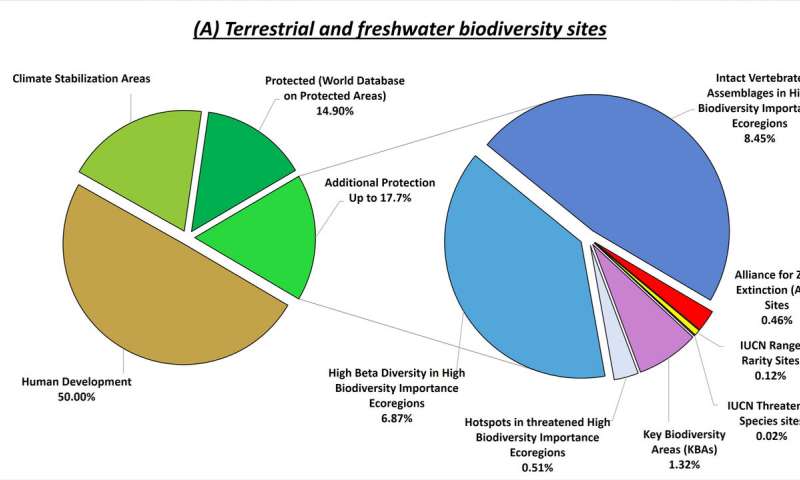

Graphical pie charts: Increasing representation of important terrestrial, freshwater, and marine biodiversity sites for global 2030 milestones. (A) Terrestrial and freshwater biodiversity sites. (B) Marine biodiversity sites. The pie charts on the right of each figure represent sites that are currently not protected. Credit: Dinerstein et al., Sci. Adv. 2019; 5:eaaw2869
There have been five mass extinctions in the history of the Earth. But in the 21st century, scientists now estimate that society must urgently come to grips this coming decade to stop the very first human-made biodiversity catastrophe.
"The sixth extinction is on our societyʻs shoulders; it really is," said ecologist Greg Asner, who serves on the faculty of the School of Geographical Sciences and Urban Planning and the School of Earth and Space Exploration and came to Arizona State University this past January to lead the new Center for Global Discovery and Conservation Science.
"We have to make a decision about where to save biodiversity, and where to let it go," said Asner. "That’s where we are now. We are playing that game as a society. Unfortunately, it’s gotten to that point because we are dominating the planet."
Asner is one of 19 international authors with a bold new science policy proposal to reverse the tide, called A Global Deal for Nature (GDN). The policy’s mission is simple: Save the diversity and abundance of life on Earth — for the price tag of $100 billion a year.
“It’s not a huge price tag,” said Asner. “That’s not a pie-in-the-sky number, but one we had to meet on and agree on. I know that those numbers are not outlandish.”
Consider that in 2018 alone, the top two most profitable U.S. companies, Apple and Berkshire Hathaway, almost matched that amount. What’s the price of saving the Earth by comparison?
Societal investment in the GDN plan would, for the first time, integrate and implement climate and nature deals on a global scale to avoid human upheaval and biodiversity loss.
While the 2015 Paris Climate Agreement was the first major accord to take global action toward climate change policies, the international team of GDN scientists believe a similar companion pact is desperately needed to implement the very first […]
Full article: To save life on Earth, here’s the $100 billion-a-year solution
Clean water is essential for life, yet millions of Americans unknowingly consume contaminants through their…
Human brains contain higher concentrations of microplastics than other organs, according to a new study, and the…
From the Office of the Governor: In anticipation of a multi-day, significant atmospheric river in Northern California,…
From Governor Newsom: Scientists, water managers, state leaders, and experts throughout the state are calling…
Photo: A harmful algal bloom in Milford Lake, Kansas, made the water appear bright green.…
An expanded plastic foam coffee cup is at a donut shop in Monterey Park, California.…